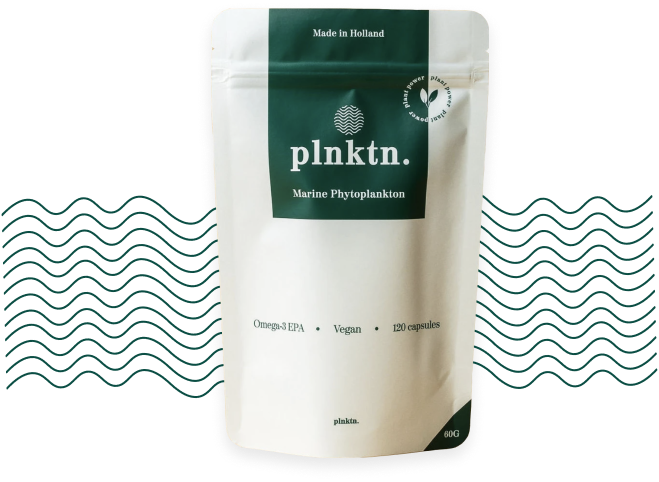Skin
Over the last few years, cosmetic companies have tried harnessing the skin enhancing properties of the sea (1). First it was caviar, then kelp, but now Marine Phytoplankton is gaining popularity. Why? Following a growing consciousness and awareness among cosmeceuticals and consumers, a need to replace synthetic ingredients with natural ingredients has emerged (2). First attempts used terrestrial - land derived - sources.
However, studies show that the compounds from marine sources show much higher biological activity han those isolated from terrestrial sources (3-4).
plnktn. contains essential amino acids, vitamins, minerals, carbohydrates, omega-3 fatty acids, and even unique pigments that have positive influence on your skin (5).
Especially the carbohydrates have been utilized in numerous cosmetic formulations, as thickening and moisturizing agents (6-8). However, a growing interest is looking at the antioxidants and omega-3 fatty acids, which are abundantly present in plnktn.

We need a healthy skin, not just a pretty skin
Did you know that the skin is your biggest, heaviest and most complex organ? It is continuously occupied with excreting metabolic products, regulating body temperature and protecting us against environmental pathogens and radiation.
Oxidative stress
During various biological reactions, free oxygen radicals are produced. These oxidative agents have the potential to protect us against invading micro-organisms. However, they also have the potential to cause damage to our normal cells when the amount of these oxidants exceeds our anti-oxidant capacity. This exceeding amount of damage is called oxidative-stress.
SKIN DAMAGE
It is well known that oxidative stress, inflammation and UV-radiation (sunlight) are responsible for damage to the skin (9). This can lead to damaged DNA, chronic inflammatory responses, decreased production of anti-oxidants, and degradation of vital skin components, such as glycosaminoglycan, elastin, and collagen (10-11). This can significantly influence its structural integrity and protective barrier function, leading to a thinner and more vulnerable skin (12). This skin is more susceptible to show wrinkling, less elasticity, and more signs of inflammation (redness, etc).
plnktn. is a primary producer of omega 3 fatty acids and unique pigments, which have powerful antioxidative and anti-inflammatory properties (13).
PROTECTING YOUR SKIN
The anti oxidative properties of the pigments and the fatty acids can scavenge the excess of damaging oxygen radicals.
On top of that, the pigments and fatty acids can decrease the production of pro-inflammatory substances, thereby decreasing the degree and duration of the inflammatory response. Additionally, a vast amount of studies show that these powerful pigments and fatty acids have the ability to activate the immune cells: this supports a rapid response, and prevents a prolonged (damaging) state of inflammation (14).
Another cause of damage to skin cells seems to be ultraviolet radiation. These pigments have been shown to posses the ability to lower and even reverse ultraviolet-induced damage to skin cells (15-18).
Different substances found in Marine Phytoplankton are able to lower and reverse damage, thereby protecting the skin.
However, we do not want a supplement which only offers high dosages of such antioxidants, seeing research has shown that such supplement might damage our health.

OTHER SUBSTANCES in Marine Phytoplankton
Zinc
plnktn. also contains zinc. Zinc plays a vital role in the skin functions, such as growth, repair and maintenance of skin, and is necessary for adequate wound healing. They also play a role in protecting cells against oxidative stress (19-22).
Amino-acids
Research has shown amino acids are needed to support a healthy condition of the skin. They support its connective tissue and the production of collagen (23). Marine Phytoplankton contains all essential amino acids.
Conclusion
In practice, studies that analyzed the intake of these pigments, fatty acids, carbohydrates, vitamins, and minerals have shown improvement of moisture content, facial elasticity and a decrease in wrinkles and microbial presence in the skin (24-32).
What do we need?
In order to protect the skin against oxidative damage, inflammation and UV-radiation, we need a combination of nutrients that posses ant-oxidative, anti-inflammatory and UV-neutralizing properties. Marine Phytoplankton offers a combination of unique nutrients such as: pigments, omega-3 fatty acids, carbohydrates, amino acids, vitamins and minerals.
plnktn. is not a replacement for your current dermatologic medication. Always consult your or our doctor before taking plnktn. as a replacement for prescribed medicine.

discover marine phytoplankton
Marine Phytoplankton, an "all-in-one" superfood full of natural nutrients.
Besides being the source of Omega-3 fatty acids, Marine Phytoplankton is rich in vitamins minerals and strong antioxidants.
The perfect supplementation to your daily nutritional needs. Discover it now:
Please click below to see which scientific articles were used to gather information concerning the subject.
(1). Snelgrove PV. An Ocean of Discovery: Biodiversity Beyond the Census of Marine Life. Planta Med. 2016 Jun;82(9-10):790-9. doi: 10.1055/s-0042-103934.Epub 2016 Apr 19. PMID: 27093252.
(2). Ruocco N, Costantini S, Guariniello S, Costantini M. Polysaccharides from the Marine Environment with Pharmacological, Cosmeceutical and Nutraceutical Potential. Molecules. 2016 Apr 27;21(5):551. doi: 10.3390/molecules21050551.PMID: 27128892; PMCID: PMC6273702.
(3). Molinski TF, Dalisay DS, Lievens SL, Saludes JP. Drug development from marine natural products. Nat Rev Drug Discov. 2009 Jan;8(1):69-85. doi:10.1038/nrd2487. Epub 2008 Dec 19. PMID: 19096380.
(4). Munro MH, Blunt JW, Dumdei EJ, Hickford SJ, Lill RE, Li S, Battershill CN,Duckworth AR. The discovery and development of marine compounds with pharmaceutical potential. J Biotechnol. 1999 Apr 30;70(1-3):15-25. doi:10.1016/s0168-1656(99)00052-8. PMID: 10412202.
(5). Hamed et al. “Marine Bioactive Compounds and Their Health Benefits:A Review”. 05 may 2015. https://doi.org/10.1111/1541-4337.12136
(6). Laurienzo P. Marine polysaccharides in pharmaceutical applications: an overview. Mar Drugs. 2010Sep 2;8(9):2435-65. doi: 10.3390/md8092435. PMID: 20948899; PMCID: PMC2953395.
(7). Cunha L, Grenha A. Sulfated Seaweed Polysaccharides as Multifunctional Materials in Drug Delivery Applications. MarDrugs. 2016 Feb 25;14(3):42. doi: 10.3390/md14030042. PMID: 26927134; PMCID:PMC4820297.
(8). Thomas NV, Kim SK. Beneficial effects of marine algal compounds in cosmeceuticals. Mar Drugs. 2013 Jan 14;11(1):146-64. doi: 10.3390/md11010146.PMID: 23344156; PMCID: PMC3564164.
(9). Timares L, Katiyar SK, Elmets CA. DNA damage,apoptosis and langerhans cells--Activators of UV-induced immune tolerance.Photochem Photobiol. 2008 Mar-Apr;84(2):422-36. doi:10.1111/j.1751-1097.2007.00284.x. Epub 2008 Jan 29. PMID: 18248501; PMCID:PMC2718731.
(10). Kammeyer A, Luiten RM. Oxidation events and skin aging. Ageing Res Rev. 2015 May;21:16-29. doi: 10.1016/j.arr.2015.01.001. Epub2015 Jan 31. PMID: 25653189.
(11). Zouboulis CC, Makrantonaki E. Clinical aspects and molecular diagnostics of skin aging. Clin Dermatol. 2011 Jan-Feb;29(1):3-14.doi: 10.1016/j.clindermatol.2010.07.001. PMID: 21146726.
(12). Rinnerthaler M, Streubel MK, Bischof J, Richter K.Skin aging, gene expression and calcium. Exp Gerontol. 2015 Aug;68:59-65. doi:10.1016/j.exger.2014.09.015. Epub 2014 Sep 26. PMID: 25262846.
(13). Davinelli S, Nielsen ME, Scapagnini G. Astaxanthin in Skin Health, Repair, and Disease: A Comprehensive Review. Nutrients.2018;10(4):522. Published 2018 Apr 22. doi:10.3390/nu10040522
(14). Park JS, Chyun JH, Kim YK, Line LL, Chew BP.Astaxanthin decreased oxidative stress and inflammation and enhanced immune response in humans. Nutr Metab (Lond). 2010 Mar 5;7:18. doi:10.1186/1743-7075-7-18. PMID: 20205737; PMCID: PMC2845588.
(15). Lyons NM, O'Brien NM. Modulatory effects of an algal extract containing astaxanthin on UVA-irradiated cells in culture. J DermatolSci. 2002 Oct;30(1):73-84. doi: 10.1016/s0923-1811(02)00063-4. PMID: 12354422.
(16). Camera E, Mastrofrancesco A, Fabbri C, Daubrawa F,Picardo M, Sies H, Stahl W. Astaxanthin, canthaxanthin and beta-carotene differently affect UVA-induced oxidative damage and expression of oxidative stress-responsive enzymes. ExpDermatol. 2009 Mar;18(3):222-31. doi: 10.1111/j.1600-0625.2008.00790.x. Epub2008 Sep 18. PMID: 18803658.
(17). Suganuma K, Nakajima H, Ohtsuki M, Imokawa G.Astaxanthin attenuates the UVA-induced up-regulation of matrix-metalloproteinase-1 and skin fibroblast elastase in human dermalfibroblasts. J Dermatol Sci. 2010 May;58(2):136-42. doi:10.1016/j.jdermsci.2010.02.009. Epub 2010 Feb 18. PMID: 20219323.
(18). Köpcke W, Krutmann J. Protection from sunburn with beta-Carotene--a meta-analysis. Photochem Photobiol. 2008 Mar-Apr;84(2):284-8.doi: 10.1111/j.1751-1097.2007.00253.x. Epub 2007 Dec 15. PMID: 18086246.
(19). Prasad AS. Zinc: an overview. Nutrition. 1995Jan-Feb;11(1 Suppl):93-9. PMID: 7749260.
(20). Heyneman CA. Zinc deficiency and taste disorders. AnnPharmacother. 1996 Feb;30(2):186-7. doi: 10.1177/106002809603000215. PMID:8835055.
(21). Prasad A.S. Chapter20-Discovery of Zinc for Human Health and Biomarkers of Zinc Deficiency. In:Collins J.F., editor. Molecular, Genetic, and Nutritional Aspects of Major andMinor Trace Minerals. AcademicPress (Elsevier); London, UK: 2017. pp. 241–260.
(22). Fabris N, Mocchegiani E. Zinc, human diseases and aging. Aging (Milano).1995 Apr;7(2):77-93. doi: 10.1007/BF03324297. PMID: 7548268.
(23). SainiR., Badole S.L., Zanwar A.A. (2013) Arginine Derived Nitric Oxide: Key toHealthy Skin. In: Watson R., Zibadi S. (eds) Bioactive Dietary Factors and Plant Extracts in Dermatology. Nutrition and Health. Humana Press, Totowa, NJ.https://doi.org/10.1007/978-1-62703-167-7_8
(24). Tominaga K, Hongo N, Karato M, Yamashita E. Cosmetic benefits of astaxanthin on humans subjects. Acta Biochim Pol. 2012;59(1):43-7.Epub 2012 Mar 17. PMID: 22428137.
(25). Cho S, Lee DH, Won CH, Kim SM, Lee S, Lee MJ, ChungJH. Differential effects of low-dose and high-dose beta-carotene supplementation on the signs of photo aging and type I pro collagen gene expression in human skin in vivo. Dermatology. 2010;221(2):160-71. doi:10.1159/000305548. Epub 2010 Jun 2. PMID: 20516658.
(26). Tominaga K, Hongo N, Karato M, Yamashita E. Cosmetic benefits of astaxanthin on humans subjects. Acta Biochim Pol. 2012;59(1):43-7.Epub 2012 Mar 17. PMID: 22428137.
(27). Sekiet al., 2001 Fragrance Journal 12:98-103. Effects of astaxanthin from Haematococcus pluvialis on human skin.
(28). Yamashita E. The effects of a dietary supplement containing astaxanthin on skin condition. Carotenoid Science. 2006; 10:91–95.
(29). Hyun-SunYoon, Hyun Hee Cho, Soyun Cho, Se-Rah Lee, Mi-Hee Shin, and Jin Ho Chung.Journal of Medicinal Food.Jul 2014.810-816.http://doi.org/10.1089/jmf.2013.3060
(30). Tominaga K, Hongo N, Fujishita M, Takahashi Y, Adachi Y. Protective effects of astaxanthin on skin deterioration. J Clin Biochem Nutr. 2017Jul;61(1):33-39. doi: 10.3164/jcbn.17-35. Epub 2017 Jun 20. PMID: 28751807;PMCID: PMC5525019.
(31). Chalyk NE, Klochkov VA, Bandaletova TY, Kyle NH,Petyaev IM. Continuous astaxanthin intake reduces oxidative stress and reverse sage-related morphological changes of residual skin surface components in middle-aged volunteers. Nutr Res. 2017 Dec;48:40-48. doi: 10.1016/j.nutres.2017.10.006.Epub 2017 Oct 10. PMID: 29246280.
(32). Ito N, Seki S, Ueda F. The Protective Role of Astaxanthin for UV-Induced Skin Deterioration in Healthy People-A Randomized,Double-Blind, Placebo-Controlled Trial. Nutrients.2018 Jun 25;10(7):817. doi: 10.3390/nu10070817. PMID: 29941810; PMCID:PMC6073124.
